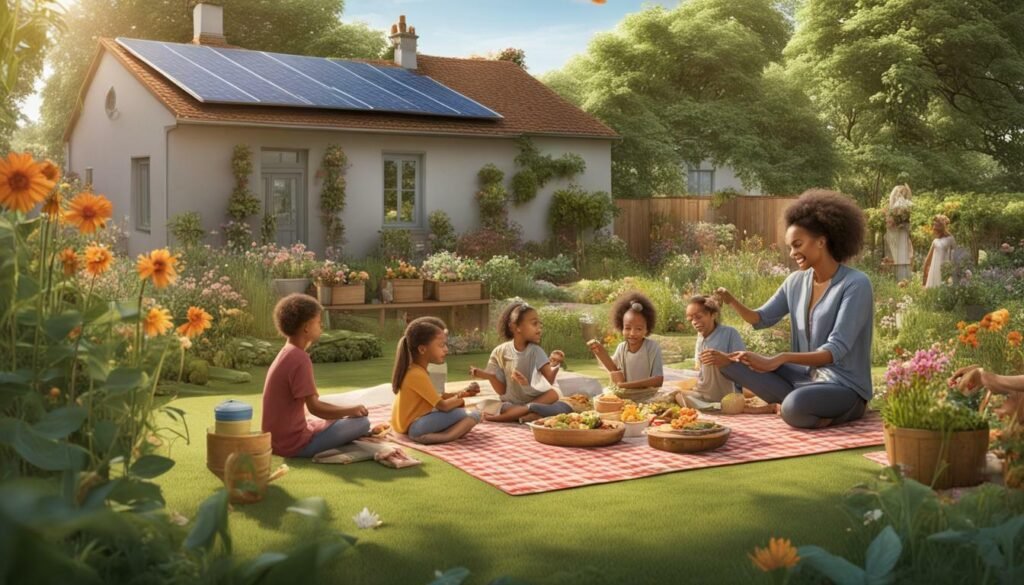As parents, we are constantly balancing the use of technology in our children’s lives with our desire for a sustainable future. In today’s digital age, it can be challenging to find the right balance between screen time and eco-conscious choices. But, with a few practical tips, we can help our children develop sustainable habits and reduce their overall impact on the environment.
Green living is more than just a buzzword; it’s about making choices that positively impact the environment. By adopting an eco-friendly lifestyle, we can reduce waste, conserve energy, and make mindful consumption decisions.
Key Takeaways:
- Parenting in the digital age requires balancing screen time with eco-conscious choices.
- An eco-friendly lifestyle is about making choices that positively impact the environment.
The Impact of Screen Time on the Environment
In today’s digital age, children are spending more time than ever before in front of screens. This widespread use of electronic devices has a significant impact on the environment, which is often overlooked. As advocates for eco-friendly and sustainable living, we must consider the environmental implications of excessive screen time for kids.
One of the most significant environmental impacts of screen time is the energy consumption of electronic devices. According to a report by the Natural Resources Defense Council, the energy consumption of household electronic devices accounts for approximately 12% of residential electricity use in the United States. This energy use not only contributes to greenhouse gas emissions but also increases our dependence on non-renewable resources.
In addition to energy consumption, electronic devices also contribute to electronic waste. The production and disposal of electronic waste have significant environmental impacts, including soil and water contamination, air pollution, and greenhouse gas emissions. According to the Environmental Protection Agency, only 25% of electronic waste is recycled, leaving the majority of it to end up in landfills or incinerators.
The Impact of Screen Time on the Environment
| Environmental Impacts of Screen Time for Kids | |
|---|---|
| Energy Consumption of Electronic Devices | Contributes to greenhouse gas emissions and dependence on non-renewable resources |
| Production and Disposal of Electronic Waste | Contaminates soil and water, contributes to air pollution, and emits greenhouse gases |
As parents and guardians, it is our responsibility to educate our children on the environmental implications of their actions, including their screen time. By adopting a sustainable and eco-friendly lifestyle, we can reduce our carbon footprint and promote a healthier planet for future generations.

Tips for Balancing Screen Time and Eco-Conscious Choices
As parents, we understand the importance of setting limits on screen time for our kids. However, it’s not just about how much time they spend in front of electronic devices, but also the impact it can have on the environment. Here are some green lifestyle tips to help you balance your children’s screen time with eco-conscious choices:
Set Screen Time Limits
One way to balance screen time and eco-conscious choices is by setting screen time limits. By doing this, we can help reduce energy consumption and carbon footprint associated with electronic devices. Try to limit screen time to no more than two hours per day and encourage other activities that don’t require technology.
Engage in Outdoor Activities
Encouraging outdoor activities can be a great way to reduce screen time and connect with nature. Take a walk in the park, go for a hike, or plan a family bike ride. Not only will this help reduce energy consumption, but it also promotes physical activity and a love for the environment.
Encourage Creative Play
Another way to reduce screen time and promote eco-conscious choices is by encouraging creative play. Give your children toys and games that don’t require batteries or electricity, such as arts and crafts, board games, or building blocks. This not only encourages creativity but also reduces energy consumption and waste from disposable batteries.
Choose Eco-Friendly Products
When it comes to technology use, opt for eco-friendly products that have a lower carbon footprint and are made from sustainable materials. Look for products with energy-saving modes, devices made from recycled materials, and companies that prioritize sustainability in their production process.

Incorporating eco-conscious choices in our children’s screen time not only benefits the environment but also promotes a sustainable lifestyle for future generations. By setting screen time limits, engaging in outdoor activities, encouraging creative play, and choosing eco-friendly products for technology use, we can make a positive impact on our planet.
Promoting Sustainable Habits Through Digital Technologies
As parents navigate the challenges of screen time for kids, it’s important to remember that digital technologies can also be used to promote sustainable habits. By leveraging the power of these tools, we can teach children about eco-friendly practices and inspire a love of nature and conservation. Here are some ways we can do this:
Educational Apps
There are a variety of educational apps available that teach children about sustainability, climate change, and conservation. For example, the app “Earth-Now” by NASA provides real-time views of global climate data sets, while “Recycle Hero” teaches kids about the importance of recycling. By incorporating these apps into our children’s screen time, we can help them develop a deeper understanding and appreciation for the environment.
Online Resources for Environmental Awareness
Many online resources are available to help parents and children learn more about sustainability and eco-friendly practices. The U.S. Environmental Protection Agency website has a section dedicated to environmental education for children, with interactive games and activities. The National Wildlife Federation offers a range of educational materials on its website, including nature-themed lesson plans and conservation tips. By exploring these resources together with our children, we can spark their curiosity and encourage sustainable habits.
Virtual Experiences
Virtual experiences can also be a powerful tool for promoting sustainability. For example, virtual tours of national parks or wildlife reserves can help children develop an appreciation for nature and wildlife. Some organizations even offer virtual reality experiences that allow children to explore the wonders of the natural world from the comfort of their own home. By incorporating these experiences into our children’s screen time, we can foster a love for the environment and encourage sustainable habits.

By using digital technologies to promote sustainability, we can turn screen time into a positive force for change. By exploring educational apps, online resources, and virtual experiences together with our children, we can inspire a love for the environment and encourage sustainable habits. Let’s embrace the power of technology to build a more eco-friendly future for ourselves and future generations.
Building an Eco-Conscious Lifestyle as a Family
At the heart of an eco-friendly lifestyle is the conscious effort to contribute positively to the environment. As parents, we have the responsibility to lead by example and encourage sustainable living practices in our children.
One way to do this is by reducing waste in our homes. Simple actions such as using reusable containers, recycling, and composting can significantly reduce our carbon footprint. We can also conserve energy by turning off electronics when not in use, using energy-efficient light bulbs, and adjusting the thermostat.
Mindful consumption is another aspect of sustainable living that can be incorporated into our daily routines. We can make eco-conscious choices by choosing products made from sustainable materials, buying locally sourced produce, and minimizing the use of single-use plastic.
Participating in eco-friendly community initiatives is also an excellent way to build an eco-conscious lifestyle as a family. Volunteering for local environmental organizations or joining community clean-up events can make a significant impact on the environment and instill a sense of responsibility in our children.

By making small changes in our daily lives, we can contribute to a healthier planet. As a family, we can embrace sustainable living practices and inspire future generations to do the same.
Promoting an Eco-Friendly Lifestyle for the Future
In today’s digital age, it’s important to consider the impact of screen time on the environment and our children’s well-being. As we strive for a sustainable future, it’s crucial to adopt eco-conscious practices in our daily lives and as a family.
By making small changes to our habits, we can make a big impact on the planet. We can start by choosing eco-friendly products for our technology use and actively participating in community initiatives for a greener lifestyle. As parents, we can lead by example and encourage our children to embrace sustainable habits.
Reducing waste, conserving energy, and practicing mindful consumption are all steps we can take towards a more eco-friendly lifestyle. We can also engage in outdoor activities as a family, immersing ourselves in nature and fostering a love for the environment in our children.
Through digital technologies, we can promote sustainable habits in our children, from educational apps to online resources for environmental awareness. We can help our children understand the importance of conservation and inspire them to make a positive impact on the world.
As we navigate screen time for our children, we must also consider the impact of digital technologies on the environment. By balancing screen time with eco-conscious choices, we can ensure a sustainable future for generations to come.
Embracing an Eco-Friendly Lifestyle
Let’s make a commitment to embracing an eco-friendly lifestyle and instilling these values in our children. Together, we can make a difference in the world and create a sustainable future for all.
Join us in our mission towards a more eco-conscious lifestyle.
FAQ
Q: What is the impact of excessive screen time on the environment?
A: Excessive screen time contributes to energy consumption, electronic waste, and carbon footprint.
Q: How can parents balance their children’s screen time while making eco-conscious choices?
A: Parents can set screen time limits, encourage outdoor activities and creative play, and choose eco-friendly products for technology use.
Q: How can digital technologies be used to promote sustainable habits in children?
A: Digital technologies can be used through educational apps, online resources for environmental awareness, and virtual experiences that foster a love for nature and conservation.
Q: How can families build an eco-conscious lifestyle?
A: Families can reduce waste, conserve energy, practice mindful consumption, and participate in eco-friendly community initiatives.

